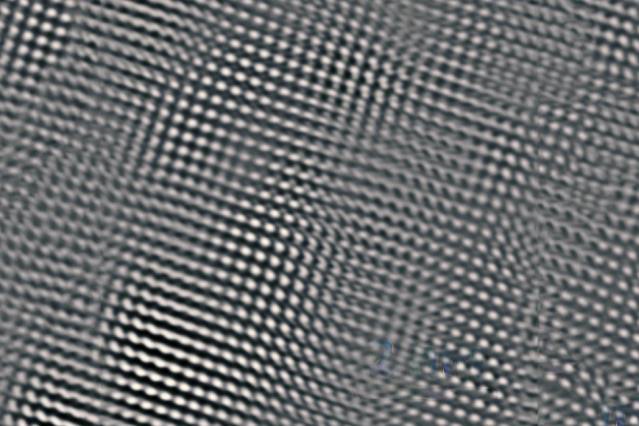Dec 18 2014
A research team from MIT has revealed a new mathematical link between temperature, material thickness and electrical resistance, which appears to be valid for all superconductors.
 Atoms of niobium and nitrogen in an ultrathin superconducting film that helped MIT researchers discover a universal law of superconductivity. Image: Yachin Ivry
Atoms of niobium and nitrogen in an ultrathin superconducting film that helped MIT researchers discover a universal law of superconductivity. Image: Yachin Ivry
The results obtained helps understand the nature of superconductivity and can also result in superior quality superconducting circuits for applications such as ultra-low power computing and quantum computing.
According to the first author of the paper and a postdoc in MIT’s Research Laboratory of Electronics, Yachin Ivry, “We were able to use this knowledge to make larger-area devices, which were not really possible to do previously, and the yield of the devices increased significantly.”
Ivry is part of the Quantum Nanostructures and Nanofabrication Group, led by Karl Berggren, an electrical engineering professor and one of the co-authors on the paper. The group specializes in the study of thin superconductor films, among other things.
Superconductors can be defined as materials which at temperatures close to absolute zero, show no electrical resistance implying that it takes minimal energy to render them electrically conductive. They can be used as quantum photodetectors since one photon will easily perform the magic. A computer chip fabricated with superconducting circuits can use one-hundredth the amount of energy as a conventional chip.
“Thin films are interesting scientifically because they allow you to get closer to what we call the superconducting-to-insulating transition,” Ivry says. “Superconductivity is a phenomenon that relies on the collective behavior of the electrons. So if you go to smaller and smaller dimensions, you get to the onset of the collective behavior.”
Ivry specifically analyzed niobium nitride, a material that researchers favor since it has a comparatively high critical temperature in its bulk form. The critical temperature can be termed as the temperature at which transition takes place from an ordinary metal to a superconductor. Similar to most superconductors, the critical temperature during deposition on thin films, on which nanodevices are dependent, is low.
Theoretical work characterized previously depicted the critical temperature of niobium nitride as a function of either the film thickness or its measured resistivity at ambient temperature. However, none of the theories seemed to validate Ivry’s results. “We saw large scatter and no clear trend,” he says. “It made no sense, because we grew them in the lab under the same conditions.”
Hence the research team performed a sequence of experiments in which either sheet resistance or thickness were kept constant and the other parameter was altered, after which the modifications in critical temperature were determined. Sheet resistance may be defined as the resistance of the material per unit area. They were able to see an obvious pattern – Thickness multiplied by critical temperature gave a constant, which can be called A and that divided by sheet resistance raised to a power can be called as B.
Ivry derived that formula and then verified it against other results shown in the superconductor literature. The initial enthusiasm waned away with the first external paper he referred to. Even though maximum number of results correlated with his formula, two were totally skewed. A co-researcher familiar with the external paper stated that the authors had clearly mentioned in a footnote that those two measurements may have experimental error since when their test device was constructed they did not remember to turn on one of the gases normally used for film deposition.
Ivry consulted several other niobium nitride papers, which bore out his results hence he started expanding to other superconductors. Each new material studied necessitated that the formula’s constants had to be adjusted; however the general equation was valid across results obtained for around 36 different superconductors.
It was not strange that each superconductor must have its own related constant, however Berggren and Ivry were not pleased that the equation needed two constants. Ivry plotted A against B for all the superconductors studied and found that the results formed a straight line.
Since the constants seemed to have a direct relationship, he began depending on only one of them in the general form of the equation. It was surprising that the materials at either end of the line had unique physical properties. Those present at the top had amorphous or highly disordered crystalline structures whereas those present at the bottom were granular or more orderly. Hence the initial attempt of Ivry to get rid of inelegance in his equation may shed some light on superconductor physics at small scales.
“None of the admitted theory up to now explains with such a broad class of materials the relation of critical temperature with sheet resistance and thickness,” says Claude Chapelier, a superconductivity researcher at France’s Alternative Energies and Atomic Energy Commission. “There are several models that do not predict the same things.”
According to Chapelier, he is keen on finding a theoretical explanation for that relationship. However, meanwhile “this is very convenient for technical applications,” he says, “because there is a lot of spreading of the results, and nobody knows whether they will get good films for superconducting devices. By putting a material into this law, you know already whether it’s a good superconducting film or not.”
Their findings are enumerated in the latest Physical Review B issue.